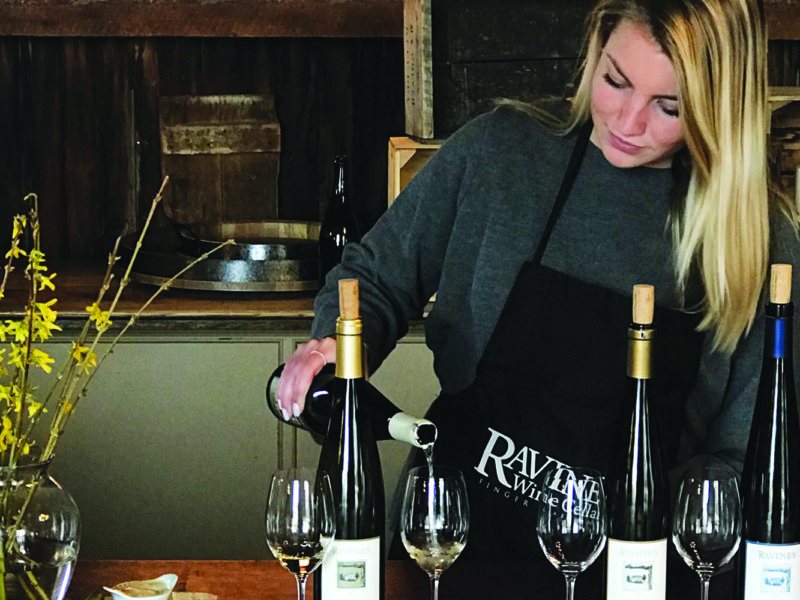
ADVERTISEMENT
By Sarah Thompson
It might be a gamble, but Morten Hallgren at Ravines Wine Cellars is betting on red. Over the last 15 years, he’s watched our region’s red wines make huge strides. Now, Hallgren believes the Finger Lakes—with its undeniable resemblance to the best wine regions of northern Europe—is poised to become the leading American region for cool-climate, age-worthy reds.
The pendulum swings back
Today, Americans’ knowledge of cool-climate reds is limited. California’s warm, Mediterranean-like climate has dominated their palate for years, producing reference wines for a generation of drinkers. Hallgren suggests a motto for these and other New World wines could be “more, more, more”: more ripeness, more color, more oak and more alcohol. But a shift is happening as consumers become increasingly interested in culinary culture, and pairing food and wine.
“We’re seeing the pendulum swing back to the desire for a more balanced style,” he says.
Still, most of the wine consumed today is warm-climate wine, and drinkers are less comfortable with the vintage variation of classic cool-climate reds like those from France’s Bordeaux and Burgundy regions or Italy’s Piedmont.
“We [winemakers] have to be aware of this. Whether we like it or not, Finger Lakes red wines require some time to be enjoyable,” Hallgren says.
Transparent Winemaking
It’s not easy to change consumer tastes or to make red wine in the Finger Lakes. Especially because we likely have more vintage variation than any other region, Hallgren says. This demands flexibility: balancing ripeness with fruit quality, reading every season and reevaluating every year. Then why not forgo reds altogether if they’re finicky and need age to enjoy? Hallgren believes the benefits are too great not to try. So, he’s embraced what he describes as a traditional, or transparent, winemaking philosophy. That is, that a well-made wine should reflect its vineyard origin and vintage without interference from heavy-handed winemaking.
“We let the vineyard speak for itself. We don’t press off too quickly, or scale back, just because we need to make a wine that’s ready to drink now,” he saysAll of Ravines’ red wines start fermenting in three-ton open-top oak fermenters, made locally using American oak from New York state. The reds also get a cold soak, simply because it takes about a week for fermentation to start; the oak fermenters help retain heat as temperatures outside are dropping. During fermentation, Hallgren continues his hands-off, hands-on approach, limiting cap management to early in the process in order to avoid extracting bitter compounds.
Hallgren also believes that oak plays a critical role in the Finger Lakes, particularly in softening and rounding out our high-acid, lightly structured reds. His red wines see long barrel and bottle aging; he believes three years on average in bottle is ideal. But too much oak can overpower the bright, fresh red fruit characteristics we get from, say, Pinot Noir. That’s why Hallgren is transitioning to using large oak casks for aging, with a lower surface-area-to-volume ratio. This spring, he added eight 540-gallon casks to his cellar; by next year he’ll have 10 more plus one larger, 50-hectoliter cask (about 1,320 gallons).
“Oak uptake is notthe reason we bought these,” he says. “We keep oak in a supporting role, getting slow oxygenation that helps all processes.”
Worth the wait
Today, about 35% of Ravines’ 26,000-case annual production is red wine, including rosé, and that number is likely to rise. Hallgren will soon plant more Cabernet Franc, a varietal he can’t keep in stock and one he sees becoming the leading red in the Finger Lakes. He’s also planning to plant Gamay, the variety used to make French Beaujolais wine. Meanwhile, in Hallgren’s personal cellar, nearly 8,500 bottles of wine are waiting to be assessed: Ravines wines going back to 2002, plus bottles from Bordeaux, Burgundy and Beaujolais to compare them with.
“Maybe I’m naive, but some people hold on to these wines, so I want be able to tell them what to drink,” he says.
Of course, Hallgren wants more drinkers to be comfortable cellaring his wines, and vertical tastings are crucial to the effort. Ravines now offers another set of library wines in the tasting room using a Coravin, a system for accessing wine in bottle while leaving the cork in place for protection. It’s a unique opportunity to taste site and vintage, and to begin expanding consumer tastes to embrace the true potential of our cool-climate reds.
“We’re unique on the American wine scene. You don’t see this style almost anywhere else outside of Europe,” Hallgren says. “When made traditionally, Finger Lakes wines can age for decades.”
WINES TO TRY
Cerise: In French, cerisemeans cherry, and that’s exactly what you get on the nose with this wine. It’s a blend of Pinot Noir and Blaufränkisch, with ripe red fruit, soft tannins and subtle spice. The 2012 vintage reminds Hallgren of a Cru Beaujolais.
Cabernet Franc: Hallgren is selling out of his Cabernet Franc faster than he can supply it. The 2018 vintage will be the first aged 100% in large oak casks, spending one year in cask plus a few months in barrel. Ravines’ newest release, 2016, is a Finger Lakes anomaly: a red wine to drink now, thanks to that year’s extreme hot, dry conditions. The 2011 and 2014 vintages also are available to taste, compare and buy.
Maximilien: Ravines just released their 2014 vintage of this meritage blend of Cabernet Sauvignon, Cabernet Franc and Merlot. Cabernet Sauvignon predominates, spending at least 17–18 months in barrel. Consumers can taste the substantial vintage variation across 2009, 2011 and 2012. Hallgren says these wines would continue to improve, and could be cellared for well over a decade.
Sarah Thompson is a writer, certified yoga teacher and small vineyard owner living in Penn Yan. She also is author of Finger Lakes Wine Country (Arcadia Publishing, 2015), an archival visual history covering more than 150 years of grape-growing and winemaking in the Finger Lakes region.

